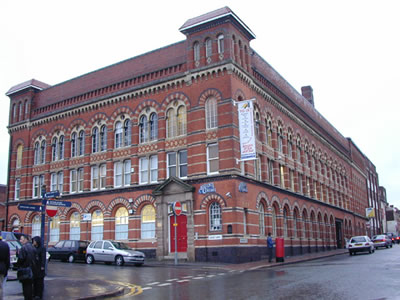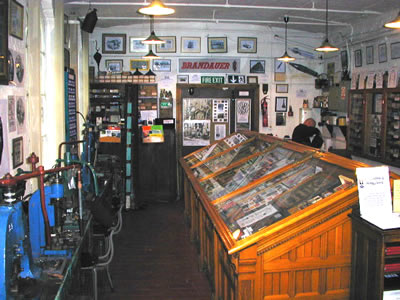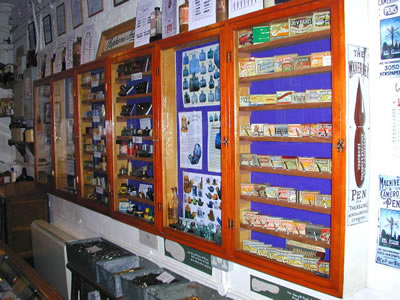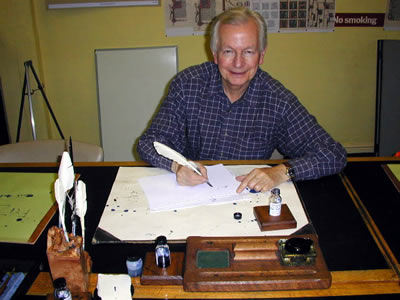| The Birmingham Pen Room | |||
| by Stuart Williams | |||
| Article # 213 | Article Type: Report | ||
| A few months ago, I found a battered old black ebonite fountain pen in a junk shop in Wednesbury, and I was intrigued by the writing on the gold nib – ‘Pope, B’ham’. Now, I had a vague idea that Birmingham, England, which is Britain’s second largest city, just north of my home in Bloxwich, had been a major manufacturer of pens at one time, and so I decided to search the internet for info on Birmingham pens, in hopes of tracing the ‘Pope’. There was not much to be found on the pen, but there was information on a remarkable survival of the old pen trade, housed in a former pen factory – The Birmingham Pen Room Museum.
But why a Pen Room in Birmingham? Well, in the early 19th century, steel pen nibs were still made by hand, and so were far more expensive than the traditional goose quill pens, costing as much as two days pay for a labourer – each! However, as the Industrial Revolution took off, Birmingham began to become a centre for industry, manufacturing and especially metalworking, and from the early 1820’s the use of modern precision hand-stamping techniques began to bring the cost of steel pen nibs down, falling dramatically from a price of 12 1/2 old pennies each to as little as 1 1/4 old pennies per Gross – 144 nibs in total! This of course was a great revolution in itself, making cheap writing instruments available to the masses and no doubt aiding in the progress of education. I myself remember using old Birmingham-made dip pens in primary school in England in the 1960’s, but those days were numbered…
For more than 130 years, the majority of pen nibs made in the world, both steel and gold, were manufactured in Birmingham, England, and many that were not made there were produced in factories in other countries owned by Birmingham manufacturers, such as Esterbrook, early exporters to, and manufacturers in, the United States of America. At the peak of the pen trade, more than 5000 mainly female workers produced over 1,500 million pen nibs a year in Birmingham alone. Sadly, the arrival of the cheap ballpoint pen in the 1950’s and 1960’s sounded the death knell for the majority of dip and fountain pen production around the world, and in due course the Birmingham pen trade, which had become dominated by Josiah Mason, Joseph Gillott and the Mitchell brothers, was decimated. Today there are one or two small Birmingham firms still making parts for the revived but still relatively small modern pen trade, such as the clips for Conway Stewart fountain pens (made by Vic Morall of L. Morall & Co. Ltd.), but little else survives, and many of the buildings are long gone. One of the huge factories which did survive, however, was the Albert Works, established in 1863 for W. E. Wiley, and today, now known as the Argent Centre, this beautiful Victorian building is the home of a fine and growing small museum and educational facility celebrating the former greatness of the Birmingham pen trade – The Birmingham Pen Room Museum.
The building, Grade II* listed, is most attractive, as you can see from the photograph, being built in the Italianate ‘Lombardic’ style, and is located in Frederick Street, part of Birmingham’s historic and well-promoted Jewellery Quarter. In fact when I was last there (on a rather wet Friday morning!), a large party of American tourists was being led around the fascinating streets of this historic part of the city, and when I first visited the Pen Room I met an American lady and her Argentinian husband, a university professor attending a conference in the city, which today is a major centre for such events. Surprisingly, more foreign visitors seek out the Pen Room than locals – maybe you, gentle reader, will be one such in the future? On the Frederick Street side of the Argent Centre is the entrance to the Birmingham Pen Room, which is run by the Birmingham Pen Trade Heritage Association, a registered charity of which I am now delighted to be a member. The displays in the Pen Room show some of the 100,000 varieties of pen nibs made by Birmingham manufacturers in their prime. There are also extensive collections of memorabilia and ephemera, including display material, ink wells and ink bottles, Braille embossers, and pen making machinery – not to mention fountain pens! Plus, box after box of thousands upon thousands of historic pen nibs.
There are now a total of four rooms in use by the Museum. One is the main Pen Room, and another is a much smaller room devoted largely to fountain pens and dip pens as well as a range of items for sale – including books, notepads, postcards, slates and new old stock dip nibs! In addition, there are two other rooms, recently acquired, which comprise a cosy Meeting Room and a good sized Education Room, where calligraphy is taught, and where visiting groups are given talks on the heritage of the Birmingham pen trade.
The Museum is staffed by unpaid volunteers, the majority being members of the Birmingham Pen Trade Heritage Association, which costs just £10 UK pounds to join. They are both enthusiastic and knowledgeable, and without them this little corner of historic Birmingham would not exist. Brian Jones is the Secretary of the Association, and he is often to be found at the Pen Room, giving talks to groups, teaching calligraphy or chatting to the public.
The Pen Room is open from 11am to 4pm, Monday to Saturday, and from 1pm to 4pm on Sundays. Admission is free but visitors are invited to make a donation in support of the museum. If you would like to contact the BPTHA, their address is The Pen Room, Unit 3 The Argent Centre, 60 Frederick Street, Birmingham B1 3HS. Or, you can email Brian Jones: brianjones@pentalk.freeserve.co.uk. And finally, if any Pentracer plans to visit the Birmingham Pen Room, why not email me and let me know when you will be there? I’d be delighted to meet you if I can - and show you the modern pen shops of Birmingham! Stuart Williams |
|||





